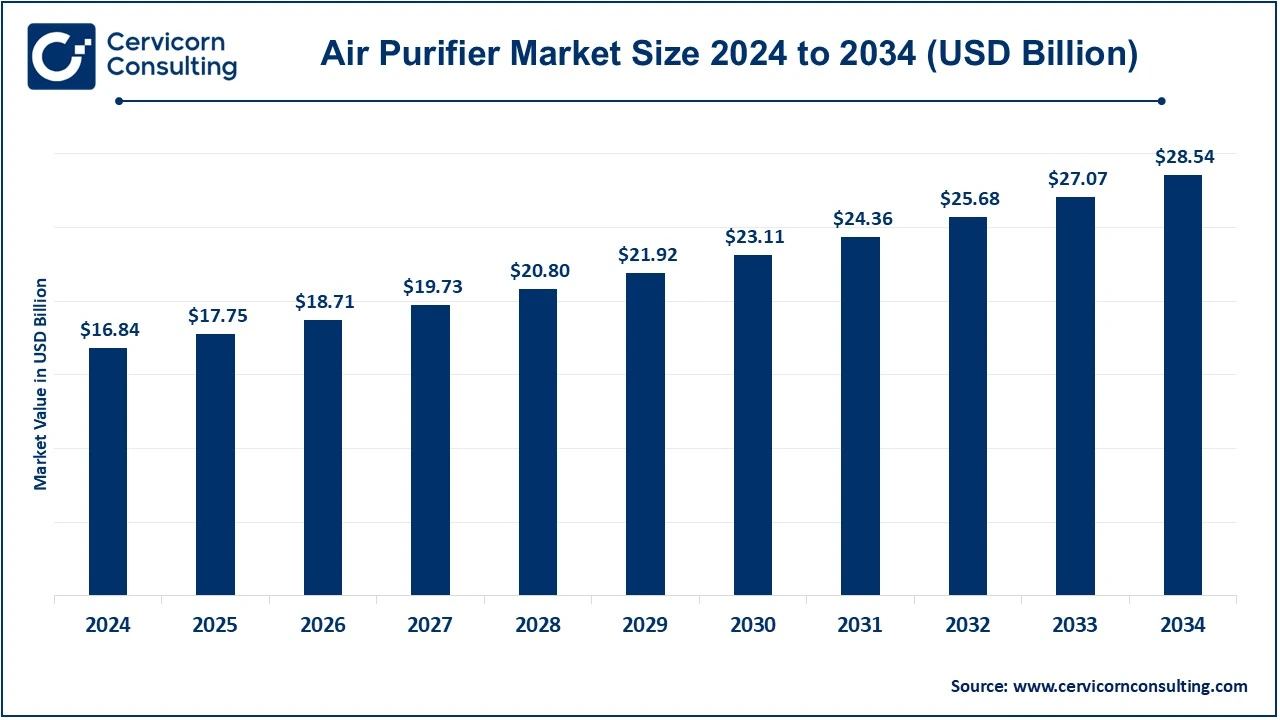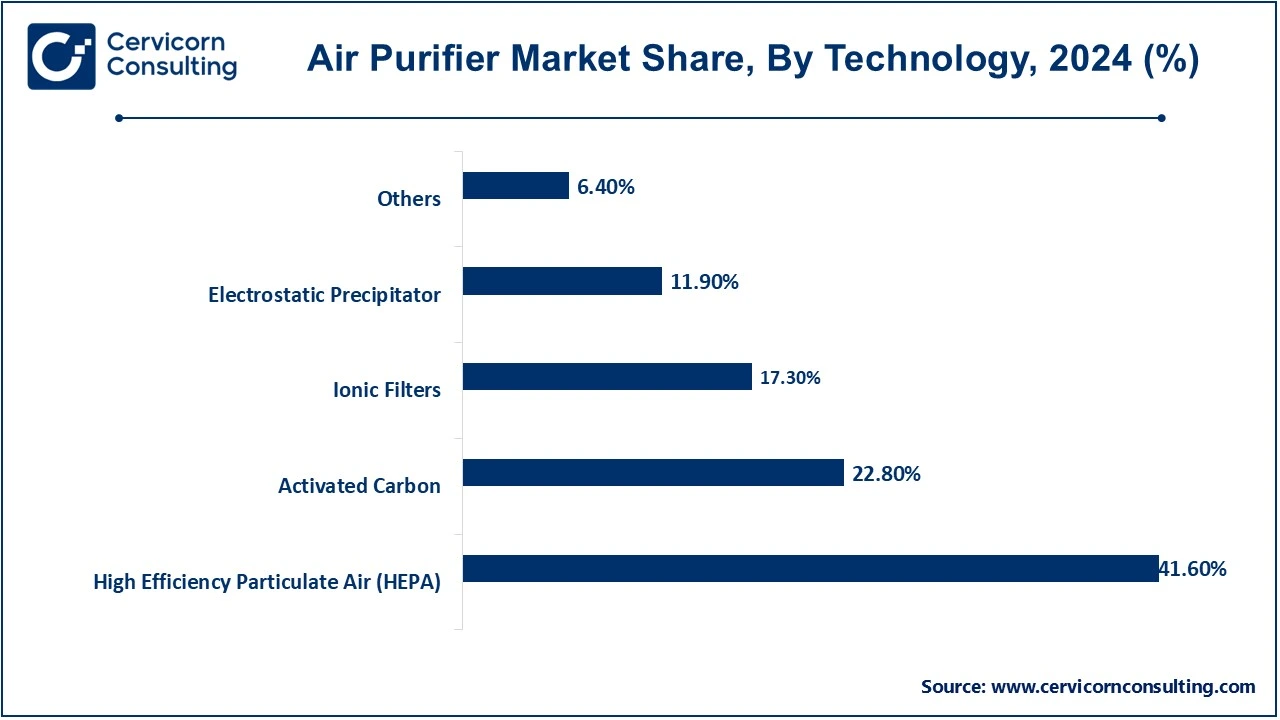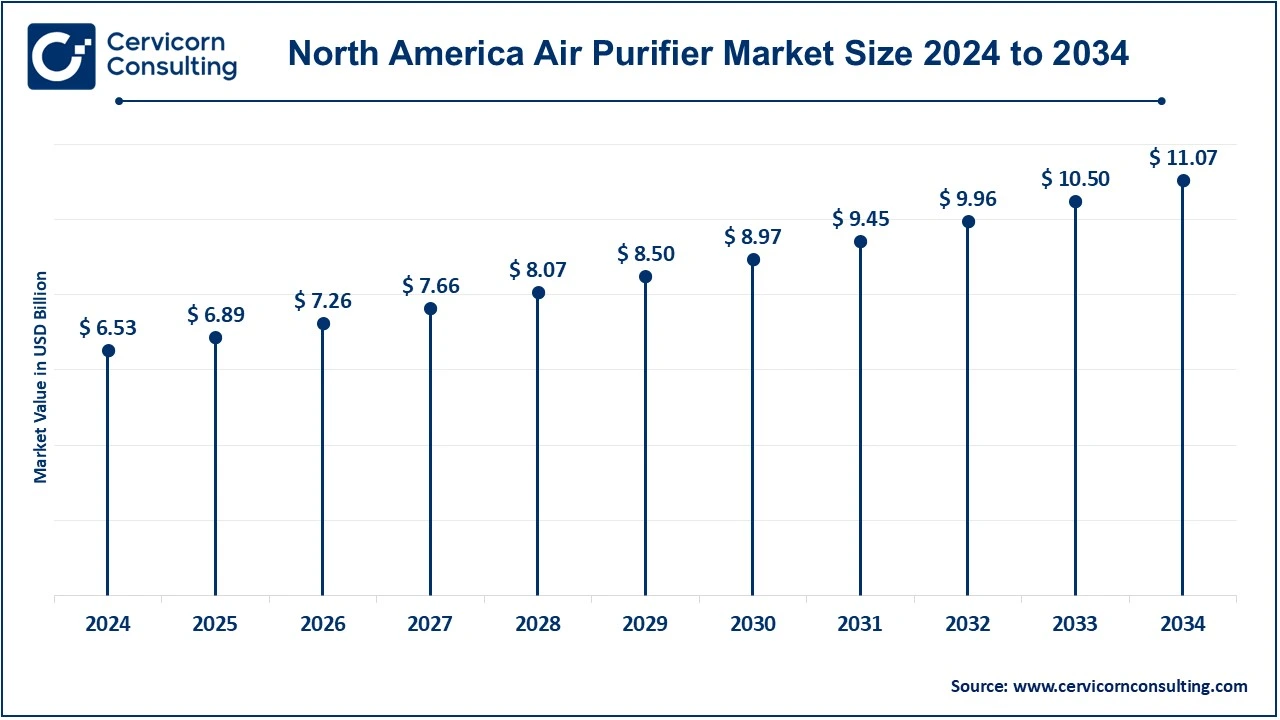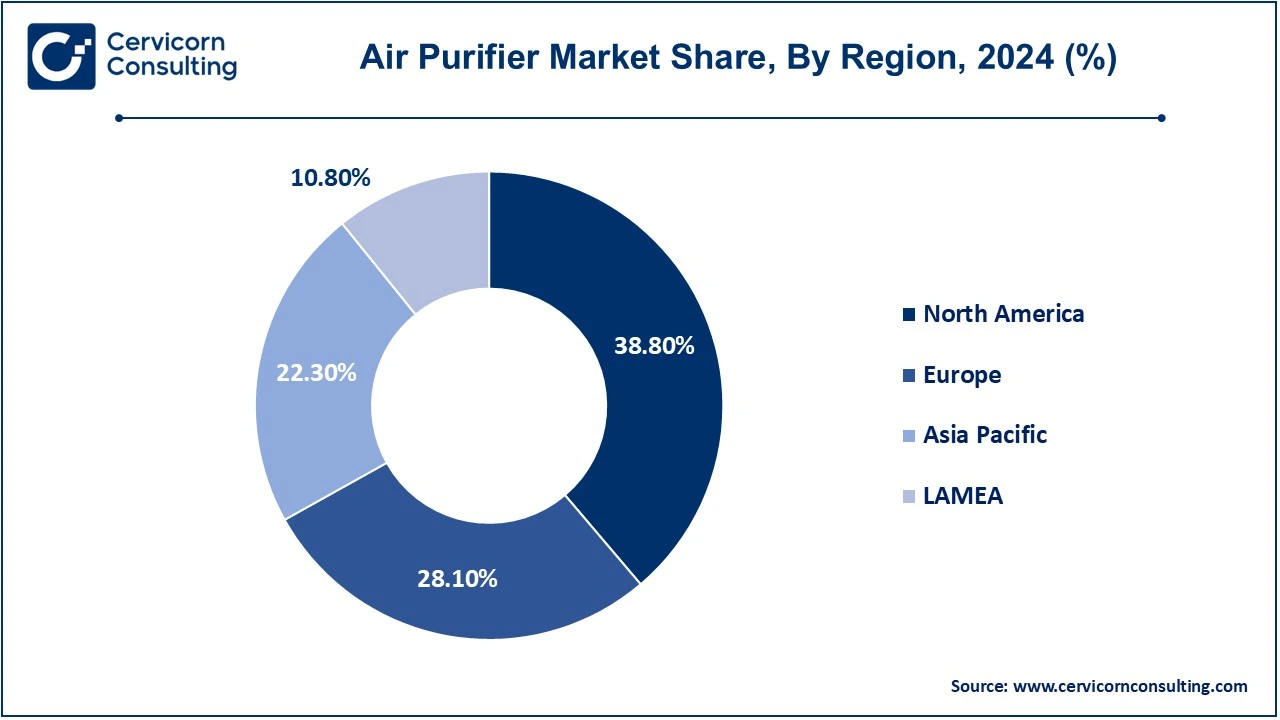The global air purifier market size was valued at USD 16.84 billion in 2024 and is expected to be worth around USD 28.54 billion by 2034, growing at a compound annual growth rate (CAGR) of 5.41% over the forecast period 2025 to 2034. The U.S. air purifier market size was estimated at USD 4.57 billion in 2024 and is projected to reach USD 7.75 billion by 2034.

The air purifiers market is growing rapidly due to increasing demand for advanced, energy-efficient systems from residential, commercial, and industrial sectors. Rising concerns over indoor air quality and pollution have led to the widespread adoption of air purifiers in homes, offices, and healthcare facilities. Stricter environmental regulations and growing health consciousness have also driven the acceptance of eco-friendly air purifiers. Technological advancements, such as IoT-enabled and HEPA-filter-equipped devices, enhance operational efficiency while lowering maintenance costs. Continuous R&D investments fuel innovation, improving air purifier performance and durability across diverse applications. These developments position air purifiers as an essential and cost-effective solution for improving air quality, ensuring robust market growth in response to regulatory and consumer demands.
Report Highlights
CEO Statements
COWAY CO., LTD. – Lee Jin-woo, CEO
Dyson Ltd. – Sir James Dyson, CEO
Report Scope
| Area of Focus | Details |
| Market Size in 2024 | USD 16.84 Billion |
| Projected Market Size in 2034 | USD 28.54 Billion |
| Estimated CAGR 2025 to 2034 | 5.41% |
| Dominant Region | North America |
| Rapidly Expanding Region | Asia-Pacific |
| Key Segment | Type, Technology, Coverage Range, Sales Channel, End User, Region |
| Key Companies | Honeywell International, Inc., IQAir, Koninklijke Philips N.V, Unilever PLC, Sharp Electronics Corporation, Samsung Electronics Co., Ltd., LG Electronics, Panasonic Corporation, Whirlpool Corporation, Dyson, Carrier |
Rise of Airborne Diseases
Rise of Pollutants from Industrial Activities
Rising Consumer Health Consciousness
High Initial Investments
High Ongoing Costs of Replacement Filters
Low Awareness in Rural and Low-Income Areas
Emerging Markets Are the Growing Potential Areas
Developing Solar-Powered Air Purifiers
Demand on the Workspace and Academic Field
Higher Price Sensitivity by Consumers
Counterfeit Products Eroding Market Trust
Crafting Products For Specific Usage
The air purifier market is segmented into type, technology, coverage range, sales channel, end user, region. Based on type, the market is classified into stand-alone and in-duct. Based on technology, the market is classified into high efficiency particulate air (HEPA), activated carbon, ionic filters, electrostatic precipitator, and others. Based on coverage range, the market is classified into below 250 Sq. Ft., 250-400 Sq. Ft., 401-700 Sq. Ft., and above 700 Sq. Ft.. Based on sales channel, the market is classified into online, and offline. Based on end user, the market is classified into residential, commercial, and industrial.
High-Efficiency Particulate Air filter: The HEPA segment has dominated the market in 2024. HEPA technology is one of the most used filtration methods in air purification. It is capable of capturing particles as small as 0.3 microns, including allergens, dust, and bacteria. HEPA filters are perfect for people who are allergic or have problems with their lungs. These filters have been included in some brands' air purifiers by Sharp and Honeywell in order to provide high-efficiency filtering for residences and businesses.
Activated Carbon: Activated carbon creates a mechanism where it can absorb air smells, smoke, and volatile organic compounds. These filters can be used to eliminate smells from cooking, pet dander, or smoke. Many air purifiers, like those by Austin Air, combine activated carbon with HEPA technology because it provides a complete air solution.

Ionic Filters: Ionic filters emit negatively charged ions into the air, which attach themselves to airborne particles and create larger clusters that either drop to the ground or tack on to other surfaces. While ionic purifiers are rather effective in mold and heavy-duty dust and allergen removal, they may produce ozone gas, which bothers the lungs in greater concentrations. Oreck has integrated ionic technology into its air purifiers to deal with fine particulate pollution.
Electrostatic Precipitator: Electrostatic precipitators carry a charge of electricity as a means to capturing the particles out of air. It efficiently filters out dust and pollen and smoke. Unlike HEPA filters, electrostatic precipitators do not need regular changes of filters. For instance, these employ electrostatic technology by which air purifiers generally eliminate contaminants but with a touch of ease.
Stand-alone: Stand-alone air purifiers refer to independent machines designed to eliminate air impurities in a single room or area. Usually, they are compact and easy to operate, equipped with different types of filtration technologies like HEPA or activated carbon. These types of units are customarily suitable for household and other smaller commercial applications, with flexibility and mobility as an added advantage. Examples include the Dyson Pure Cool, which is known for air purification combined with cool air for personal spaces.
In-duct: In-duct air purifiers are placed in a building’s HVAC system for whole building or facility air cleaning. They are best used in bigger spaces and for commercial applications, giving a central air filtration feature. This would require professional installation and maintenance, which enhances ongoing air quality, as seen in industries and multi-story buildings. In this case, in-duct filtration systems are offered by Trane for large commercial environments.
Commercial: The commercial segment has dominated the market in 2024. Commercial air purifiers are installed in offices, hotels, hospitals, and other suites to provide a strictly clean and safe environment for employees, customers, and patients. Often, they will need to cover superior spaces and provide a higher capacity for such. The brands of commercial air purifiers, such as Blueair and IQAir, can be used to ensure that businesses run a healthy environment, improve productivity, and keep airborne pathogens, allergens, and pollutants at bay.
Air Purifier Market Revenue Share, By End User, 2024 (%)
| End User | Revenue Share, 2024 (%) |
| Commercial | 57% |
| Residential | 30% |
| Industrial | 13% |
Residential: Air purifiers for homes would just work within the households in cleaning the quality of air by removing various pollutants like dust, allergens, and odors. With growing awareness among consumers about the health risks posed by air pollution, so more and more homeowners are buying air purifiers. Various brands of air purifiers for the residential market, such as Honeywell and Coway, aim for the various needs of their customers, for instance, controlling allergens or removing VOCs.
Industrial: Industrial air purifiers have been specifically designed as part of extensive systems for removing hazardous chemicals, particulates, or other pollutants, and can be installed in factories, warehouses, as well as in any production plants. Air purifiers, therefore, are highly used in industries like manufacturing and pharmaceuticals. Their applications range from high performance industrial air purifiers such as Camfil, which meet regulatory standards for workplace air safety in industries.
The air purifier market is segmented into various regions, including North America, Europe, Asia-Pacific, and LAMEA. Here is a brief overview of each region:
The North America air purifier market size was valued at USD 6.53 billion in 2024 and is expected to reach around USD 11.07 billion by 2034. With increased consciousness of not only the harm to health but also the complete need for healthiness, especially due to the most recent government exactions to improve standards on air quality, demand for air purifiers is one of the fastest-growing in North America. North America comprises the US, which has a relatively enhanced market share in the region for air purifiers in homes and offices. Silk partners include Honeywell, IQAir, and Dyson as having one of the most varied combinations of advanced filtration technologies geared toward recovering indoor air quality across cities under poor air quality situations.

The Europe air purifier market size was estimated at USD 4.73 billion in 2024 and is projected to reach around USD 8.02 billion by 2034. Rising consumer awareness in Europe for indoor air pollution and health hazards has come as a boon to increase air purifier demand. Adequate strictness, such as the EU clean air initiatives, spurs the installation of air purifiers in homes, offices, and industry. Top brands in the European market include Phillips, Blueair, and Dyson, which have come forth with different novel solutions towards the improvement of air quality in residential and commercial sectors.
The Asia-Pacific air purifier market size was accounted for USD 3.76 billion in 2024 and is predicted to surpass around USD 6.36 billion by 2034. In the Asia-Pacific region, growing urbanization and industrialization lead to an increasingly growing market demand for air purifiers, given the air pollution activities in China and India. Knowledge about risks posed by airborne contaminants motivates the demand for air purifiers in households, commercial establishments, and industries. Leading manufacturers include Xiaomi, Panasonic, and Sharp, who offer energy-efficient air purifiers primarily targeted for home users and business sectors.

The LAMEA air purifier market size was valued at USD 1.82 billion in 2024 and is anticipated to reach around USD 3.08 billion by 2034. It has been noticed that LAMEA has significantly catapulted to becoming one of the most interesting markets for air washers in the last 2 years – particularly in Brazil, UAE, and South Africa, where pollution typically occurs at very high levels due to urbanization. Increasing awareness about possible health risks doubled with a continuous increasing in disposable income creates demand for air purification systems. With the likes of Airfree and Sharp extended their reach within this segment, introducing localized solutions for residential and commercial needs.
Recent strategic product launches in the air purifier industry reflect a strong commitment to advancing technology, improving efficiency, and meeting the increasing demand for cleaner, healthier indoor air. These innovations are designed to address growing concerns over air pollution, allergens, and airborne diseases, while incorporating features like energy efficiency, smart technology integration, and enhanced filtration systems. Companies are also responding to consumer preferences for user-friendly, eco-friendly solutions.
Market Segmentation
By Type
By Technology
By Coverage Range
By Sales Channel
By End user
By Region